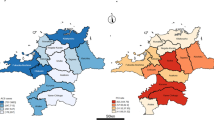Abstract
Study objectives: To investigate the geographical distribution of Percutaneous Transluminal Coronary Angioplasty (PTCA) and morbidity for coronary heart disease, angina pectoris and myocardial infarction by spatial analysis of the standardized morbidity rates (SMR) on district level. To identify clusters by Moran's I Statistic and the Regional Spatial Autocorrelation Coefficient (RSAC) of Munasinghe and Morris. To investigate demand factor morbidity and supply factor health care infrastructure on the district level as reasons for geographical disparity. To describe characteristics of the cluster population and intervention centres. Study design: Retrospective record linkage study. Setting: All hospitals and cardiological centres in Austria (n = 150) which performed the Minimum Basic Data Set (MBDS). Patients: All Austrian residents who were diagnosed for myocardial infarction, coronary heart disease or angina pectoris in 1995 (n = 87,174). Measurements and main results: One ‘positive’ PTCA cluster (all SMRs ≥ 0.96) and one ‘negative’ PTCA cluster (all SMRs ≤ 0.59) were identified. They differed significantly in morbidity rate, intervention rate and available cardiological beds. The tendency to inverse relation between PTCA utilization and morbidity in the ‘negative’ cluster supported the thesis of ‘inverse care law’. Austrianwide no significant correlation was found between the SMR of PTCA-application and both demand factor and supply factors. Nevertheless, differences between the clusters concerning number and capacity of intervention centres and density of specialists pointed to supply factors as reasons for geographical disparity. The ongoing trend of steady expansion of existing intervention centres and establishment of new ones will reduce the extent of geographical variation in future.
Similar content being viewed by others
References
McPherson K, Strong PM, Epstein A, Jones L. Regional variations in the use of common surgical procedures within and between England and Wales, Canada and the United States of America. Soc Sci Med 1981; 15A: 273–288.
Vayda E. A comparison of surgical rates in Canada and in England and Wales. New Engl J Med 1973; 289: 1224–1229.
Sanderson HF. Regional variation in cataract extraction rates and their relationship with resource supply and need. J R Soc Med 1980; 73: 492–496.
Black NA. Geographical variation in the use of surgery for the glue ear. J Soc Med 1985; 78: 641–648.
Van den Brand M, and the European Angioplasty Survey Group. Utilization of coronary angioplasty and costs of angioplasty disposables in 14 Western European countries. Europ Heart J 1993; 14: 391–397.
Working Party of the British Cardiac Society. Coronary angioplasty in the United Kingdom. Br Heart J 1991; 66: 325–331.
Higginson LAJ, Cairns JA, Keon WJ, Smith ER. Rates of cardiac catheterization, coronary angioplasty and open-heart surgery in adults in Canada. Can Med Assoc J 1992; 146: 851–859.
Black N, Langham S, Petticrew M. Coronary revascularisation: Why do rates vary geographically in the UK? J Epidemiol Community Health 1995; 49: 408–412.
Findlay IN, Cunningham D, Dargie HJ. The effect of cardiac catheterization facilities on the rate of coronary bypass grafting in Scotland. Br Heart J 1992; 68: 69.
Brook RH, Park RE, Winslow CM, Kosecoff JB, Chassin MR, Hampton JR. Diagnosis and tratment of coronary artery disease: Comparison of doctor's attitudes in the USA and the UK. Lancet 1988; 1: 750–753.
Van den Brand M, van Halem C, van den Brink F. Comparison of costs of percutaneous transluminal coronary angioplasty and coronary bypass surgery for patients with angina pectoris. Eur Heart J 1990; 11: 765–771.
Kuhn E, Hartz A, Baras M. Correlation of rates of coronary artery bypass surgery and angioplasty among 305 SMSAs for Medicare patients. Proceedings of the 10th Annual Meeting of the American Health Services Research Association. Washington DC, 1993.
Strauss R, Pfeifer C, Mühlberger V, Ulmer H, Pfeiffer KP. Effects of morbidity, age, gender and region on percutaneous transluminal coronary angioplasty (PTCA) utilization. Public Health (paper in print).
BM für Gesundheit, Sport und Konsumentenschutz. Diagnosenschlüssel ICD-9 KRAZAF 1993. Wien: Österreichische Staatsdruckerei, 1993.
Mühlberger V. Guidelines for coronary angiography referrals (Version 2/95). Cor Europaeum 1995; 4(1): 30–32.
Pepine CJ. ACC/AHA guidelines for cardiac catheterization and cardiac catheterisation laboratories. Circulation 1991; 84: 2213.
Kux KH, ed. Handbuch für die Sanitätsberufe Österreichs. Adress-und Nachschlagewerk über das Österreichische Gesundheitswesen. 1995. Wien: Dieter Göschl, 1995.
Fisher LD, Belle van G. Biostatistics. A methodology for the health sciences. Chichester: Wiley, 1993: 770.
Upton G, Fingleton B. Spatial data analysis by example. In: Walter A, Wilks S, Wilks SS (eds), Wiley Series in probability and mathematical statistics, Vol I. Chichester: John Wiley & Sons Ltd, 1985: 170.
Munasinghe RL, Morris RD. Localization of disease clusters using regional measures of spatial autocorrelation. Stat Med 1996; 15: 893–905.
Hart JT. The inverse care law. Lancet 1971; II: 405–412.
Pilote L, Granger C, Armstrong PW, Mark DB, Hlatky MA. Differences in the treatment of myocardial infaction between the United States and Canada: A survey of physicians in the GUSTO trial. Med Care 1995; 33: 598–610.
The GUSTO Investigators. An international randomized trial comparing four strategies for acute myocardial infarction. N Engl J Med 1993; 329: 673–682.
Jollis JG, DeLong ER, Peterson ED. Outcome of acute myocardial infaction according to the speciality of the admitting physician. N Engl J Med 1996; 335: 1880–1887.
Ayanian JZ, Guadagnoli E, McNeil BJ, Cleary PD. Treatment and outcomes of acute myocardial infaction among patients of cardiologists and general physicians. Arch Intern Med 1997; 157: 2570–2576.
Ayanian JZ, Landrum MB, Normand SL, Guadagnoli E, McNeil BJ. Rating the appropriateness of coronary angiography — do practicing physicians agree with an expert panel and with each other? New Engl J Med 1998; 338: 1896–1904.
Pilote L, Miller DP, Califf RM, Rao JS, Weaver WD, Topol EJ. Determinants of the use of coronary angiography and revascularization after thrombolysis for acute myocardial infaction. N Engl J Med 1996; 335: 1198–25.
Author information
Authors and Affiliations
Rights and permissions
About this article
Cite this article
Strauss, R., Pfeifer, C., Ulmer, H. et al. Spatial analysis of Percutaneous Transluminal Coronary Angioplasty (PTCA) in Austria. Eur J Epidemiol 15, 451–459 (1999). https://doi.org/10.1023/A:1007577516433
Issue Date:
DOI: https://doi.org/10.1023/A:1007577516433




